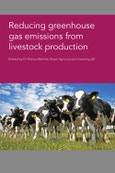Recent IPCC reports have highlighted the environmental impact of livestock production as a major source of non-CO2 emissions: methane (CH4), nitrous oxide (N2O) and ammonia (NH3). The livestock sector must react to these reports and develop or implement methods that can reduce greenhouse (GHG) emissions from livestock production. Reducing greenhouse gas emissions from livestock production provides authoritative reviews on measuring GHG emissions from livestock as well as the range of methods that can be applied to reduce emissions, ranging from breeding to animal health and manure management. The collection also reviews nutritional approaches such as improving forage quality and the use of plant bioactive compounds and other feed supplements to limit emissions by modifying the rumen environment. Drawing in an international range of expert authors, Reducing greenhouse gas emissions from livestock production summarises what we can do to make livestock production more sustainable and viable for the future. It will be a major reference for the livestock (particularly dairy) science research community, environmental scientists, government and other agencies tackling the challenge of climate change, as well as companies involved in livestock production and processing of dairy and meat products.
Audience: University and other livestock (particularly dairy) science researchers; environmental scientists; government and other agencies tackling the challenge of climate change; companies involved in livestock production and processing of dairy and meat products
Audience: University and other livestock (particularly dairy) science researchers; environmental scientists; government and other agencies tackling the challenge of climate change; companies involved in livestock production and processing of dairy and meat products
Table of Contents
Part 1 Analysis
Part 2 Breeding, animal husbandry and manure management
Part 3 Nutrition








